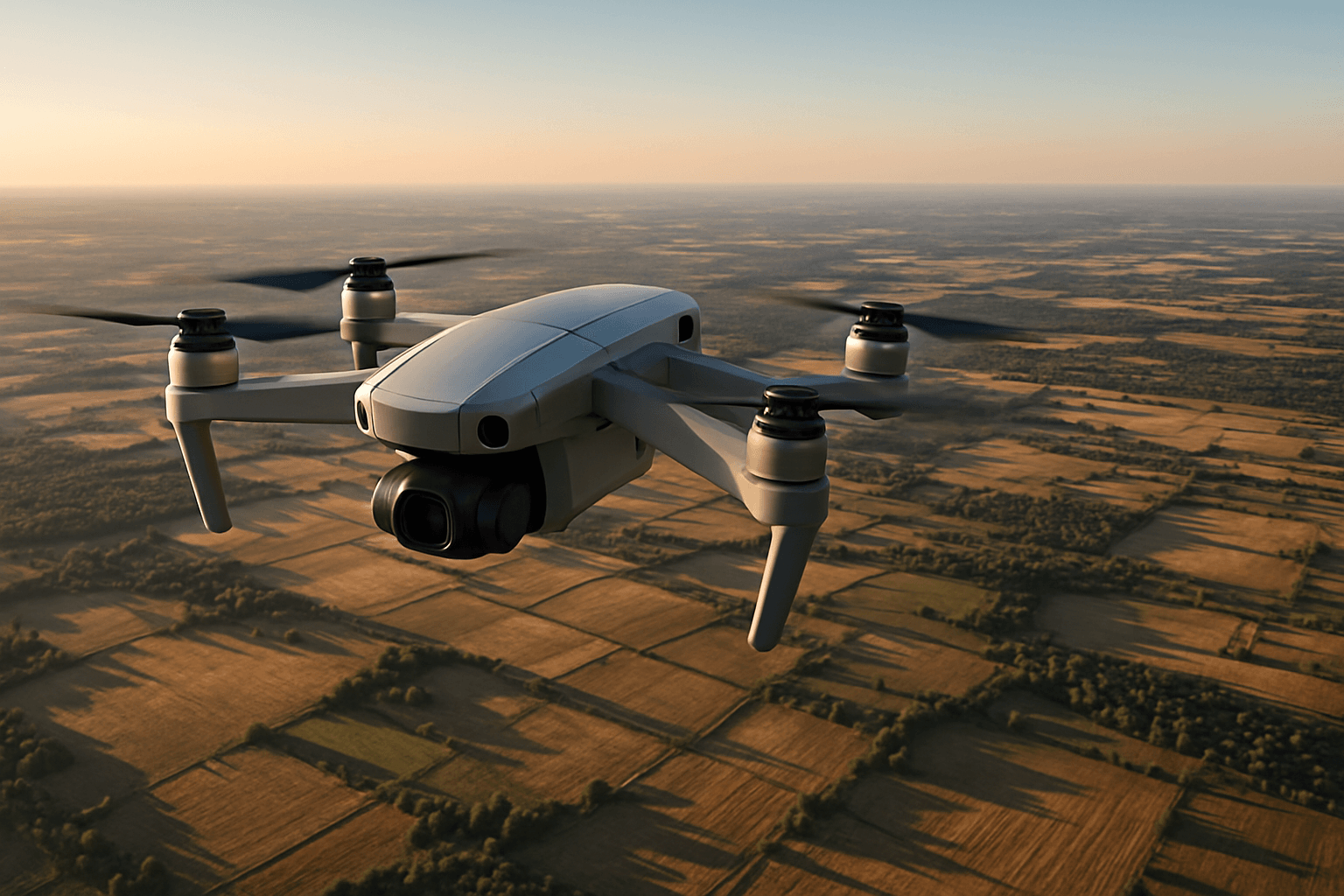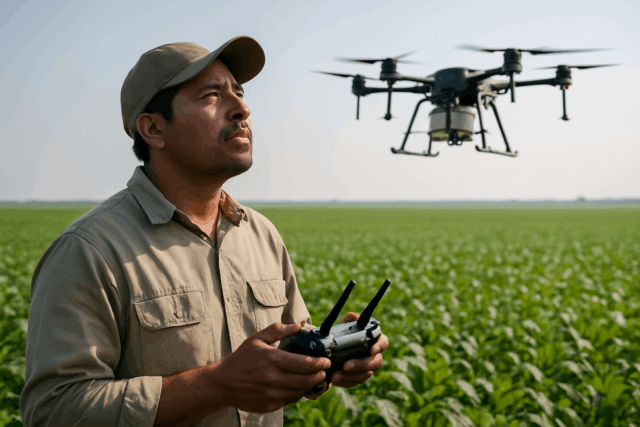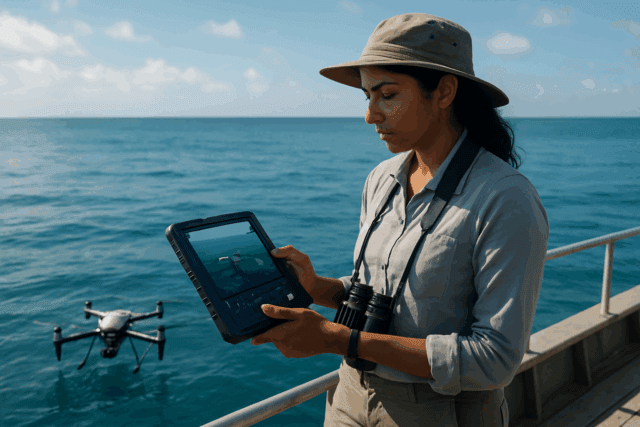Drones have become increasingly popular, both for recreational and professional use. One of the most critical aspects to consider when choosing a drone is its range – how far it can fly from the controller before losing connection or running out of battery. Understanding the factors that influence drone range and the legal limitations is essential for safe and efficient operation. This article dives deep into the world of drone range, exploring the key determinants, legal considerations in the UK, and top long-range drone models available in 2025.
What Determines the Flight Range of a Drone?
A drone’s flight range is influenced by a combination of factors, including its design, environmental conditions, and operational variables. Let’s break down these elements:
1. Drone Design and Components
- Battery Capacity: The battery is the primary power source. Larger battery capacities generally translate to longer flight times and, consequently, greater range. However, it’s a balancing act, as larger batteries add weight, potentially reducing efficiency. Lightweight, high-energy-density batteries are ideal for maximizing range.
- Size and Weight: A heavier drone requires more power to stay airborne, thus limiting its range. Streamlined, aerodynamic designs can reduce drag and improve flight efficiency.
- Propulsion System: Efficient motors and propellers are crucial. Motors that provide higher thrust with less power consumption contribute to longer flight durations. The design and material of the propellers also affect how effectively motor power is converted into thrust.
- Signal Strength: The strength and reliability of the signal between the drone and its controller significantly impact the operational distance. Advanced controllers with stronger signals allow drones to operate farther from the pilot, as long as communication is maintained.
- Materials and Design Optimization: The use of advanced materials and innovative design approaches can significantly enhance a drone’s performance, contributing to extended range.
2. Environmental Conditions
- Wind Conditions: Wind can significantly impact a drone’s range. Headwinds force the drone to use more energy to maintain its position, reducing range, while tailwinds can extend it.
- Temperature: Extreme temperatures can affect battery performance. Cold temperatures can reduce battery efficiency, while high heat can cause overheating, both shortening flight distance.
- Precipitation: Heavy rain and snow can impede control and reduce the range. Moisture in the air, like fog or rain, can also degrade signal quality.
- Altitude and Air Density: Flying at higher altitudes can sometimes extend a drone’s range due to thinner air reducing drag, although this can also affect engine and propeller efficiency.
- Terrain: Obstacles such as buildings, trees, and mountains can interfere with the signal, limiting operational distance.
3. Operational Factors
- Flight Dynamics and Control: Aggressive maneuvers consume more energy than stable flight paths. The efficiency of the flight control system also plays a role.
- Payload: The weight of additional payloads like cameras or sensors increases the energy required for flight, reducing the potential range. It’s best to only use the necessary equipment to keep the drone’s weight optimal.
- Signal Interference: A large number of nearby antennas and devices transmitting strong radio waves, such as cellular network stations, can affect range. Flying at higher altitudes can help reduce signal interference from Wi-Fi networks, power lines, and other sources of radio frequency (RF) noise.
Maximizing Drone Range: Practical Tips
While drone design and environmental conditions play a significant role, pilots can take several steps to maximize their drone’s range:
- Optimize Antenna Placement: Positioning the antennas on the drone optimally can significantly improve the signal strength and stability.
- Use High-Gain Antennas: High-gain antennas can help focus the energy more efficiently and extend the drone’s range.
- Reduce Signal Interference: Avoid physical obstructions like buildings and trees.
- Fly in Optimal Weather Conditions: Plan flights for clear days with minimal wind to avoid signal degradation and instability.
- Minimize Payload Weight: Only carry necessary equipment to reduce the energy required for flight.
- Maintain Batteries Properly: Effective battery management is key to extending battery life. Discharge the battery to about 40%-65% if not in use for more than 10 days and store in a cool, dry place. Fully charge and discharge the battery at least every three months to maintain capacity and performance.
- Fly at Higher Altitudes: Flying at a higher altitude can help reduce signal interference from Wi-Fi networks, power lines, and other sources of radio frequency (RF) noise.
UK Drone Laws and Regulations: Range and Distance Limits
In the UK, drone operations are governed by the Civil Aviation Authority (CAA). Understanding and adhering to these regulations is crucial for legal and safe flying. Here are some key aspects of UK drone laws related to range and distance:
- Visual Line of Sight (VLOS): Pilots must maintain a direct, unaided visual line of sight with their drones at all times. Using binoculars, telescopes, or cameras on the drone to maintain VLOS is prohibited. The VLOS range will differ between drone models. Smaller drones, especially those under 250g, can be more difficult to see and keep track of, potentially reducing the effective VLOS range.
- Maximum Altitude: Drones must not be flown higher than 120 meters (400 feet) above ground level.
- Distance from People:
- A minimum horizontal distance of 50 meters must be maintained between the drone and people. This creates a no-fly zone around people that extends up to the legal height limit.
- If flying higher than 50m, the horizontal distance should be the same as the height. For example, if flying at a height of 80m, keep 80m away from people.
- During takeoff and landing, this distance may be reduced to 30 meters.
- Distance from Built-up Areas: Drones weighing 250g or more must remain 150 meters away from residential, commercial, or industrial zones.
- Restricted Airspace: Permission is required before flying in restricted airspace, such as near airports, government buildings, and military bases. No flying within a 5-kilometer (3-mile) radius of airports.
- Drone Registration and Flyer ID: Operators must register with the CAA and obtain an Operator ID if the drone weighs over 250g or has a camera that can take photos or record video. Anyone flying a drone that weighs over 250g must pass a basic test with the CAA to get a Flyer ID.
Open Category Subcategories:
- A1 (Flying Over People): Allowed for drones under 250g.
- A2 (Flying Close to People): Requires a C2 drone and an A2 Certificate of Competency. Allows pilots to fly small drones up to 2kg “close to people”, maintaining a 50m horizontal separation distance from uninvolved people.
- A3 (Flying Far from People): For drones up to 25kg, only in remote areas.
Penalties for Violations:
Violating UK drone laws can result in significant fines:
- Exceeding altitude limits: Fines up to £2,500
- Flying beyond visual line of sight: Fines up to £2,000
- Unauthorized flight in restricted airspace: Fines up to £5,000
- Violating airport no-fly zone: Fines up to £7,500
- Unsafe operations (e.g., flying too close to people): Fines up to £2,500
- Flying too close to built-up areas: Fines up to £3,000
Top Long-Range Drones in 2025
While legal restrictions limit how far you can legally fly a drone, some models boast impressive technical capabilities. Here are some of the best long-range drones available in 2025:
- DJI Mavic 3 Pro: Known as the best cinema drone if budget is no object. It has a range of 9.3 miles and a battery life of 43 minutes. Features Hasselblad Four Thirds primary camera with full D-Log capture.
- DJI Mini 4 Pro: Excellent onboard camera with a 1/1.3-inch sensor and can fly up to 12.4 miles away. Endurance is around 45 minutes with the Intelligent Flight Plus battery.
- Autel Robotics Evo Lite+: Has a maximum range of 7.5 miles. Features higher resolution 6K video and a 1-inch sensor. Battery life is a very solid 40 minutes.
- Autel EVO Lite Plus: One of the standout features is its long maximum transmission range of 12 km or 7.5 miles. Provides video transmission through a stabilized 3-axis gimbal 4K camera.
- Autel EVO Pro 2 V3: Maximum transmission range of 9km (5.5 miles) under ideal conditions. Testing has shown it can achieve around 4,000 meters (2.5 miles) before the HD video signal begins to weaken and exceed 5,000 meters (over 3.1 miles).
- DJI Avata 2: Extended 13km video transmission range with improved O4 video transmission system. Features enhanced battery life, 23 minutes flight time and stable flight with GPS and visual positioning.
- DJI Air 3: Features an O4 Transmission System.
- DJI Matrice 350 RTK: Designed for mapping, surveying, and inspections. It has a flight time of up to 55 minutes and a 20 km transmission range.
- DJI Matrice 300 RTK: Designed for professional aerial inspections, mapping, and surveying. With an impressive 55-minute flight time and a 15 km transmission range.
- Autel Dragonfish Standard/Lite: VTOL (Vertical Takeoff and Landing) drones, combining the easy takeoff and landing of multirotor drones with the long-range flight efficiency of fixed-wing aircraft.
VTOL Drones:
- Volitation VT370: Flight Time: 18 hours
- Skyeye 5000 VTOL: Flight Time: 12 hours
- JOUAV CW-30E: Flight Time: 8 hours
- UAVforDrone VTOL: Flight Time: 6 hours
- T-Drones VA23: Flight Time: 4 hours (without payload)
- MotioNew FLY VTOL: Flight Time: 2.5 hours
Drones in Confined Spaces
The use of drones for confined space inspections has become a go-to solution in many industries. In confined spaces, drones can typically travel distances ranging from 200 to 500 meters, depending on factors such as the nature of the environment (metal, concrete), signal quality, and battery life.
Factors influencing distance in confined environments:
- Battery Life: Autonomy depends on battery capacity. Flying in a confined space requires frequent maneuvers and greater energy consumption management.
- Environmental Conditions: Radio signal may encounter interference due to wall materials. Metal conduits allow for better signal transmission, while concrete tends to absorb radio signals.
- Signal Range: Use of signal repeaters and drone antenna improvement can help increase the range of a drone in confined environments.
Final Thoughts
Understanding drone range is crucial for both recreational enjoyment and professional applications. By considering the factors that influence range, adhering to UK drone laws, and choosing the right equipment, you can maximize your drone’s capabilities and ensure safe and responsible flying. Whether you’re capturing stunning aerial photography, conducting inspections, or simply enjoying the thrill of flight, a well-informed approach to drone range will enhance your experience and keep you within legal boundaries.





